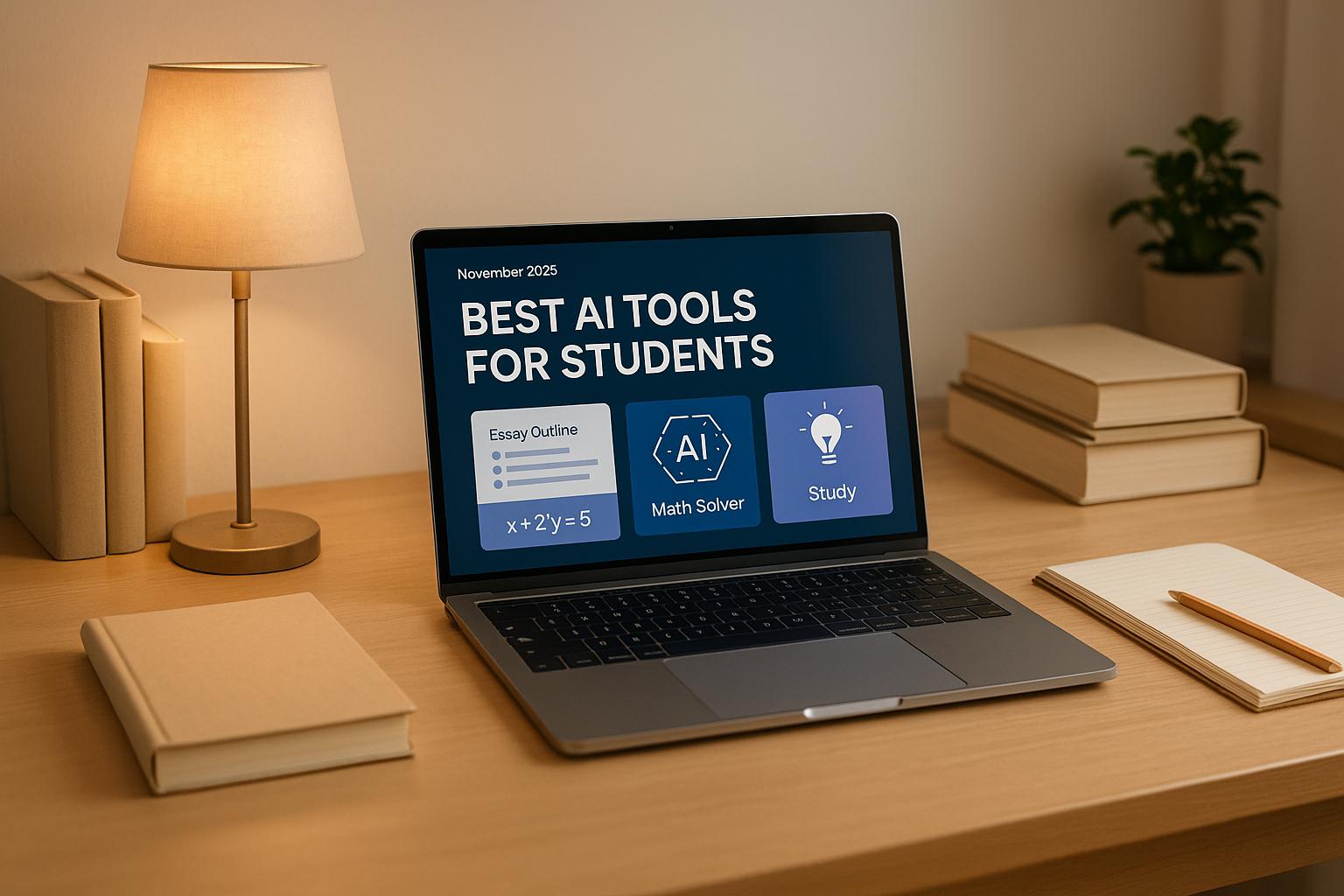ChatGPT 5, released on August 7, 2025, is OpenAI's latest and most advanced large language model (LLM). It introduces a unified architecture with a "Thinking" mode for complex tasks, improved accuracy, and multimodal capabilities. Competing models like Claude 4 Sonnet, Gemini 2.5 Pro, and Llama 4 offer specialized features, but ChatGPT 5 stands out for its balance of usability and performance across diverse applications.
Key Highlights:
- Strengths: Reliable for general tasks like coding, writing, and automation. Offers preset personalities and reduced errors.
- Competitors: Other LLMs excel in niche areas like extended context handling or advanced technical problem-solving.
- Applications: Effective in industries like healthcare, education, legal, and business operations.
- Limitations: Struggles with very long texts, recent data, and some specialized tasks.
Quick Comparison
| Feature/Model | ChatGPT 5 | Claude 4 Sonnet | Gemini 2.5 Pro | Llama 4 |
|---|---|---|---|---|
| Release Date | Aug 7, 2025 | 2025 | 2025 | 2025 |
| Strength | General tasks | Extended context | Technical tasks | Open-source focus |
| Weakness | Long documents | Slower responses | Costly | Limited tools |
| Key Use Cases | Business, education | Research, writing | Coding, logic | Custom projects |
When choosing, consider your goals, budget, and integration needs. Testing multiple models is the best way to find the right fit.
ChatGPT-5 Full Review: 5 Real-World Tests & The AI Race
Core Capabilities and Performance Analysis
ChatGPT 5's streamlined architecture boosts its performance across a variety of applications, eliminating the need for specialized adjustments.
Performance Benchmarks and Test Results
The unified design delivers reliable and consistent results across multiple benchmarks, proving its ability to handle practical tasks effectively.
These test results highlight how the architecture supports its strengths in handling specific tasks with precision.
Strengths and Weaknesses by Task Type
ChatGPT 5 demonstrates flexibility across a wide range of tasks. It strikes a solid balance, excelling in creative content generation while also tackling technical problem-solving with clarity and precision. While specialized models might outperform it in niche areas, ChatGPT 5's design ensures it remains a reliable choice for general use.
User Experience and Feature Differences
After looking at performance benchmarks, it’s time to dive into how interface design and usability shape the overall experience. Large Language Models (LLMs) vary significantly when it comes to interaction, design, and ease of use. ChatGPT 5, for instance, focuses on providing a clean, straightforward interface that keeps everything in one place. This approach helps users stay on task without needing to juggle between multiple tools or screens.
Other models, however, might take a different route. Some prioritize specialized workflows or cater to niche, domain-specific tasks. These differences make the choice of model highly dependent on what you or your organization values most. If seamless and consistent usability is key, ChatGPT 5 might be the better fit. But if the need is for a platform tailored to specific technical challenges, other options may prove more suitable.
sbb-itb-212c9ea
Industry Applications and Use Cases
The true potential of any model is best seen in how it performs across industries. Each sector has its own unique demands, and what works seamlessly for a marketing team might not meet the needs of healthcare professionals or educators. By examining practical applications, we can better understand where ChatGPT 5 and other large language models (LLMs) excel. Here's a closer look at how ChatGPT 5 fits into various industry scenarios.
When it comes to productivity and business operations, ChatGPT 5 proves to be a reliable tool. It simplifies tasks like summarizing lengthy documents, taking meeting notes, and drafting emails. These features enhance efficiency without requiring complicated setups. Its ability to retain context is particularly helpful for managing complex projects.
In marketing and content creation, ChatGPT 5 brings a conversational and creative edge. It’s great for brainstorming campaign ideas, drafting social media posts, and building customer personas. Once you establish a brand's tone, the model can maintain voice consistency, offering a balance of creativity and practicality that marketers appreciate.
Educational applications highlight another area where ChatGPT 5 stands out. Its patient, step-by-step guidance makes it an excellent resource for tutoring and curriculum development. Teachers value its ability to adjust explanations to suit different learning levels within the same conversation, all without requiring extensive technical know-how.
The automation and workflow sector underscores the importance of technical capabilities. ChatGPT 5 handles routine tasks like data entry, basic coding support, and documenting processes efficiently. Its natural language understanding makes it accessible even for non-technical users looking to automate simple workflows.
Specific Industry Examples
Let’s dive into specific use cases to see how ChatGPT 5 adapts to various industries:
- In healthcare administration, ChatGPT 5 excels at empathetic patient communications and streamlining administrative tasks. Its ability to handle sensitive language makes it a valuable tool for improving patient engagement.
- For legal document preparation, ChatGPT 5 is effective in drafting basic contracts, summarizing case notes, and organizing legal research. It also simplifies complex legal concepts, making them easier for clients to understand.
- In financial services, accuracy and compliance are critical. ChatGPT 5 supports customer service by providing clear scripts and educational content to help clients better understand financial products and services.
- In manufacturing and supply chain environments, ChatGPT 5 is useful for creating standard operating procedures and training materials. It adapts quickly to updates in processes, making it a practical choice for industries where flexibility is key.
ChatGPT 5 stands out for its ease of use and versatility across a wide range of applications. While specialized models may offer deeper functionality for niche tasks, ChatGPT 5’s broad capabilities and low setup requirements make it a go-to choice for many industries.
Limitations and Selection Criteria
Every large language model (LLM) has its strengths and weaknesses, and understanding these trade-offs is key to making an informed decision. Models like ChatGPT 5 come with impressive capabilities, but they also have limitations that can influence their effectiveness in different scenarios. Factors such as technical constraints, cost, and specific use cases play a big role in determining which model is the best fit for your needs. For example, some models prioritize speed but may sacrifice accuracy, while others excel in specialized tasks but lack general versatility.
Model Limitations Comparison
Technical factors like context window size, knowledge cutoffs, and access to real-time data can significantly impact how an LLM performs. Take ChatGPT 5, for instance - it works well with most business documents but may struggle with extremely lengthy or intricate texts. On the other hand, some models are designed with larger context capacities, making them better suited for processing extended content.
Another key limitation is the model's knowledge cutoff date. If a model’s training data only goes up to a certain point, it may lack awareness of recent developments - something that can be a drawback in industries like finance or news, where up-to-date information is critical. While some models incorporate methods to refresh their knowledge, others rely entirely on pre-trained data, which can create gaps in their utility.
Reasoning capabilities also vary. ChatGPT 5 is quite good at handling complex logic, but it might stumble with multi-step mathematical proofs or highly specialized technical challenges. In contrast, other models may excel in specific reasoning tasks but lack the conversational fluency or creative writing abilities that ChatGPT 5 offers.
Cost is another important factor, particularly for businesses with high usage demands. When comparing pricing, it’s essential to look beyond the per-token cost. A model that seems cheaper per token might require more tokens to deliver the same quality of output, which could drive up overall costs.
Understanding these technical and financial constraints is essential to choosing the right model for your specific needs.
How to Choose the Right Model
Selecting the right LLM starts with a clear understanding of your goals and resources. If your primary focus is customer service, look for models with strong conversational skills and a consistent tone. For tasks like technical documentation or code generation, prioritize models that have a proven track record in those areas.
Budget planning is equally important. Instead of just focusing on per-token costs, consider your current usage, potential future growth, and overall token consumption. This broader perspective can help you avoid unexpected expenses down the line.
Integration requirements should also be part of your evaluation. If your application depends on API connectivity, ensure the model you choose offers stable and well-documented integration options. Some models are better for standalone use, while others are designed for environments requiring custom integrations.
Consistency often matters more than occasional peak performance. For most business applications, a model that reliably produces high-quality results is more valuable than one that delivers exceptional output inconsistently or requires frequent retries to get the desired results.
Don’t overlook your team’s technical expertise and available resources. ChatGPT 5, for instance, is designed to perform well with minimal setup, making it a great choice for teams without dedicated AI specialists. However, more advanced models might offer superior capabilities but could require additional technical investment.
Scalability is another crucial consideration, especially if your business is growing. Some models maintain their performance as usage scales, while others may slow down under heavier workloads. Planning for future demands can save you from having to switch models later.
Finally, if your work involves sensitive data, make sure the model you select meets the necessary security and privacy standards. Depending on your industry, you may also need to decide whether an on-premises deployment or a cloud-based model better suits your needs.
The best way to make an informed choice is to test multiple models using real-world scenarios. Many providers offer trial periods or low-cost testing options, allowing you to assess how well a model meets your specific requirements before making a commitment.
Summary and Main Points
When comparing ChatGPT 5 to other leading language models, some key takeaways emerge to guide decision-making. ChatGPT 5 stands out for its conversational skills and ease of use, making it a strong choice for businesses seeking reliable performance without the need for extensive technical expertise. Instead of focusing on a single specialty, it offers a balanced range of capabilities.
That said, no model is perfect for every task. ChatGPT 5 excels in areas like creative writing, customer service, and general business operations. However, other models may perform better in specialized tasks such as advanced mathematical reasoning, generating complex code, or handling very lengthy documents. The trick is to align your specific needs with the strengths of each model, rather than searching for a universal solution.
Practical considerations often outweigh technical specs when determining the best fit. For example, the cost of a model isn’t just about per-token pricing - some models may require more tokens to achieve the same quality, which can increase overall expenses. It’s important to factor in your usage patterns, scalability needs, and the consistency of results when evaluating the true cost of a model.
For businesses looking to integrate language models into their workflows, AI Apps offers a robust resource for exploring and comparing AI tools. With a curated collection of over 1,000 AI applications across various categories, the platform helps users find tools that complement their selected language model. Whether it’s image generation, video editing, or automation, AI Apps’ advanced filters make it easier to pinpoint tools that match your specific needs and budget.
Before committing to a model, test multiple options with your actual use cases. Trial periods allow you to evaluate how well a model performs in real-world scenarios. Hands-on testing can uncover details that benchmarks alone might miss.
Finally, remember that your choice isn’t set in stone. As your needs change and new models become available, you can reassess and adapt. Start with a model that fits your current requirements, but keep scalability and future integration in mind.
FAQs
What makes ChatGPT 5 stand out in terms of usability and performance compared to other large language models?
ChatGPT 5 shines with its user-friendly design and powerful performance. It responds quickly, tackles intricate tasks with ease, and produces precise outputs suited for practical uses. Its knack for managing multi-step processes independently boosts productivity, making it a dependable tool across various fields like marketing, education, automation, and workflow optimization.
What sets ChatGPT 5 apart is its enhanced reasoning abilities, allowing it to craft responses that are more detailed and contextually aware. These improvements make it an invaluable resource for anyone looking to address a broad spectrum of needs, whether it's simplifying processes or generating compelling content.
What industries benefit the most from ChatGPT 5, and how does it handle specialized tasks?
ChatGPT 5 stands out when it comes to tackling specialized, industry-focused tasks. Its advanced technical capabilities and knack for processing complex data make it a go-to solution in fields like technology, finance, and scientific research, where it can assist with tasks such as coding, software development, and conducting thorough data analysis.
Beyond that, it shines in enterprise settings by automating workflows, ensuring regulatory compliance, and optimizing operations in industries like healthcare, legal services, and business analytics. With its ability to handle knowledge-heavy tasks and simplify repetitive processes, it proves to be a versatile tool that meets the demands of various professional sectors.
What challenges does ChatGPT 5 face when working with complex or lengthy documents?
ChatGPT 5 comes with a fixed context window of up to 128,000 tokens. While this is a massive improvement compared to earlier versions, it still limits how much information the model can process in one go. This restriction can make it harder to keep track of details or fully analyze very large or complex documents, sometimes leading to gaps in context or errors.
On top of that, its ability to manage long-term context over extended conversations has its challenges. This limitation can impact its effectiveness in tasks that require deep analysis or consistent focus on intricate material. If you're working with highly detailed or lengthy content, splitting the text into smaller, manageable parts can often lead to better outcomes.



